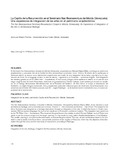Mostrar o rexistro simple do ítem
La Capilla de la Resurrección en el Seminario San Buenaventura de Mérida (Venezuela): una experiencia de integración de las artes en el patrimonio arquitectónico
| dc.contributor.author | Chacón Ramírez, José Luis | |
| dc.date.accessioned | 2019-05-30T09:44:15Z | |
| dc.date.available | 2019-05-30T09:44:15Z | |
| dc.date.issued | 2005 | |
| dc.identifier.citation | Chacón Ramírez, J. L. (2017). La Capilla de la Resurrección en el Seminario San Buenaventura de Mérida (Venezuela). Actas De Arquitectura Religiosa Contemporánea, 4, 116-125. https://doi.org/10.17979/aarc.2015.4.0.5127 | es_ES |
| dc.identifier.issn | 2340-5503 | |
| dc.identifier.uri | http://hdl.handle.net/2183/23080 | |
| dc.description.abstract | [Resumen] El Seminario San Buenaventura ubicado en Mérida (Venezuela), proyectado por Manuel Mújica Millán, constituye un patrimonio arquitectónico y una parte vital de la Ciudad de Dios del arzobispo constructor mons. Chacón. El diseño de la capilla para el Seminario Menor se asume como intervención al patrimonio por medio de una integración de las artes, cuyo tema es la resurrección de Cristo. En un lenguaje austero, la obra de arte es —siguiendo a Le Corbusier— «présense insigne». Esta integración fue ideada y guiada por el TiA (Taller i Arte + Arquitectura). El foco visual y litúrgico de la capilla es el retablo, en el cual del vano mayor surge la obra de Cristo Resucitado, elaborada en guadamecil por Gómez Callejas, quien señala que el icono es resultado de un trabajo denominado «Manifestaciones de la Realidad del Misterio». El vano menor lo ocupa el tabernáculo del Santísimo, un objeto litúrgico restaurado. Arte y arquitectura pretenden enlazarse para dar testimonio de la Encarnación viva: presencia sacramental del misterio pascual, cuyo fin —según Ratzinger— es la transformación mediante la cruz y la nueva corporeidad de la resurrección. | es_ES |
| dc.description.abstract | [Abstract] The San Buenaventura Seminary is located in Mérida (Venezuela). Designed by Manuel Mújica Millán, it has become a local architectonic heritage, and an essential part of mons. Chacón´s —the constructor archbishop— City of God. The chapel for the Minor Seminary was designed as a heritage intervention through an integration of the arts, in which the theme is Christ’s resurrection. With an austere language, the work of art stands as Le Corbusier’s «présense insigne». This integration was carried out by the TiA (Taller i Arte + Arquitectura). The visual and liturgical focus is the retable, in which Gómez Callejas’ work of Christ risen made in cuir de cordoue surges from the larger opening. It is the result of a work called «Reality Manifestations of the Mystery». The smaller opening is occupied by the tabernacle, a restored liturgical object. This way, art and architecture intend to be bonded in order to testify a live Incarnation: sacramental presence of the mystery of Passover, which has the objective of transformation through the cross and the new body of resurrection, according to Ratzinger | es_ES |
| dc.language.iso | spa | es_ES |
| dc.publisher | Universidade da Coruña | es_ES |
| dc.relation.uri | https://doi.org/10.17979/aarc.2015.4.0.5127 | es_ES |
| dc.rights | Atribución-NoComercial 4.0 España | es_ES |
| dc.rights.uri | http://creativecommons.org/licenses/by-nc/3.0/es/ | * |
| dc.subject | Integración de las artes | es_ES |
| dc.subject | Patrimonio | es_ES |
| dc.subject | Capilla de la Resurrección | es_ES |
| dc.subject | Mérida | es_ES |
| dc.subject | Venezuela | es_ES |
| dc.subject | Integration of the arts | es_ES |
| dc.subject | Heritage | es_ES |
| dc.subject | Chapel of the Resurrection | es_ES |
| dc.title | La Capilla de la Resurrección en el Seminario San Buenaventura de Mérida (Venezuela): una experiencia de integración de las artes en el patrimonio arquitectónico | es_ES |
| dc.title.alternative | The San Buenaventura Seminary Resurrection Chapel in Mérida (Venezuela): An Experience of Integration of the Arts in Architectural Heritage | es_ES |
| dc.type | info:eu-repo/semantics/article | es_ES |
| dc.rights.access | info:eu-repo/semantics/openAccess | es_ES |
| UDC.journalTitle | Actas de Arquitectura Religiosa Contemporánea | es_ES |
| UDC.volume | 4 | es_ES |
| UDC.startPage | 116 | es_ES |
| UDC.endPage | 125 | es_ES |






